I recently traveled in Palestine-Israel with a delegation from Interfaith Peace-Builders, returning to the U.S. just as news about the settler kidnapping and the escalation of repression in the West Bank emerged. The intense escalation of violence in Palestine-Israel over the last several weeks has been portrayed as the most recent flare-up in a long-standing conflict. Especially during a time of such intensified violence, it is important to remember that the periods of calm and quiet in the US media obscure the status quo system of structural violence experienced by Palestinians living under occupation on a daily basis. The current escalation of pyrotechnic violence of missiles, air strikes and rockets that has captured world attention is highly visible, urgent and devastating. Yet, the less visible, and often forgotten, structural violence of the occupation that I witnessed on my trip is ongoing.
As a first time visitor to the region, and as someone who had studied this so-called conflict extensively in an academic setting, it was incredibly powerful and disturbing to witness the visual manifestations of the occupation and to meet people working to bring peace with justice to the region. Infrastructure plays a subtle yet violent role in enforcing and expanding the Israeli Occupation of the West Bank. The separation wall, check points, the plethora of barbed wire, settler-only roads running over Palestinian underpasses, and rooftop water tanks are visually striking elements of the architecture of occupation. Equally striking, however, is the resilience and strength of popular resistance against the occupation.
What follows are photographs and captions depicting infrastructural manifestations of occupation and the vibrancy of Palestinian resistance. At the end of the photo essay, I reflect on my trip now that I’m back home.
Naomi Dann’s tour.
Infrastructure plays a subtle yet violent role in enforcing and expanding the Israeli Occupation of the West Bank. For a first time visitor to the region, infrastructural elements such as the separation wall, check points, the plethora of barbed wire, settler-only roads running over Palestinian underpasses, and rooftop water tanks are visually striking elements of the architecture of occupation. Equally striking, however, is the resilience and strength of popular resistance against the occupation. What follows are photographs and captions depicting infrastructural manifestations of occupation and the vibrancy of Palestinian resistance, captured during a recent Interfaith Peace-Builders solidarity trip.

In Jerusalem the separation wall bisects the historic road to Jericho, dead-ending the biblical route that has carried thousands of pilgrims for centuries. This part of the so-called “security fence” divides two Palestinian neighborhoods from each other by means of concrete slabs topped with barbed wire, dividing people from their businesses and children from their schools.

In Hebron, checkpoints restrict movement within the city and have destroyed business in the main commercial areas (see Open Shuhadeh Street). Barbed wire, gates, fences, surveillance cameras, soldier/snipers, and metal detectors are an insidious part of the urban landscape in a city where the visual manifestations of the occupation are never out of sight.
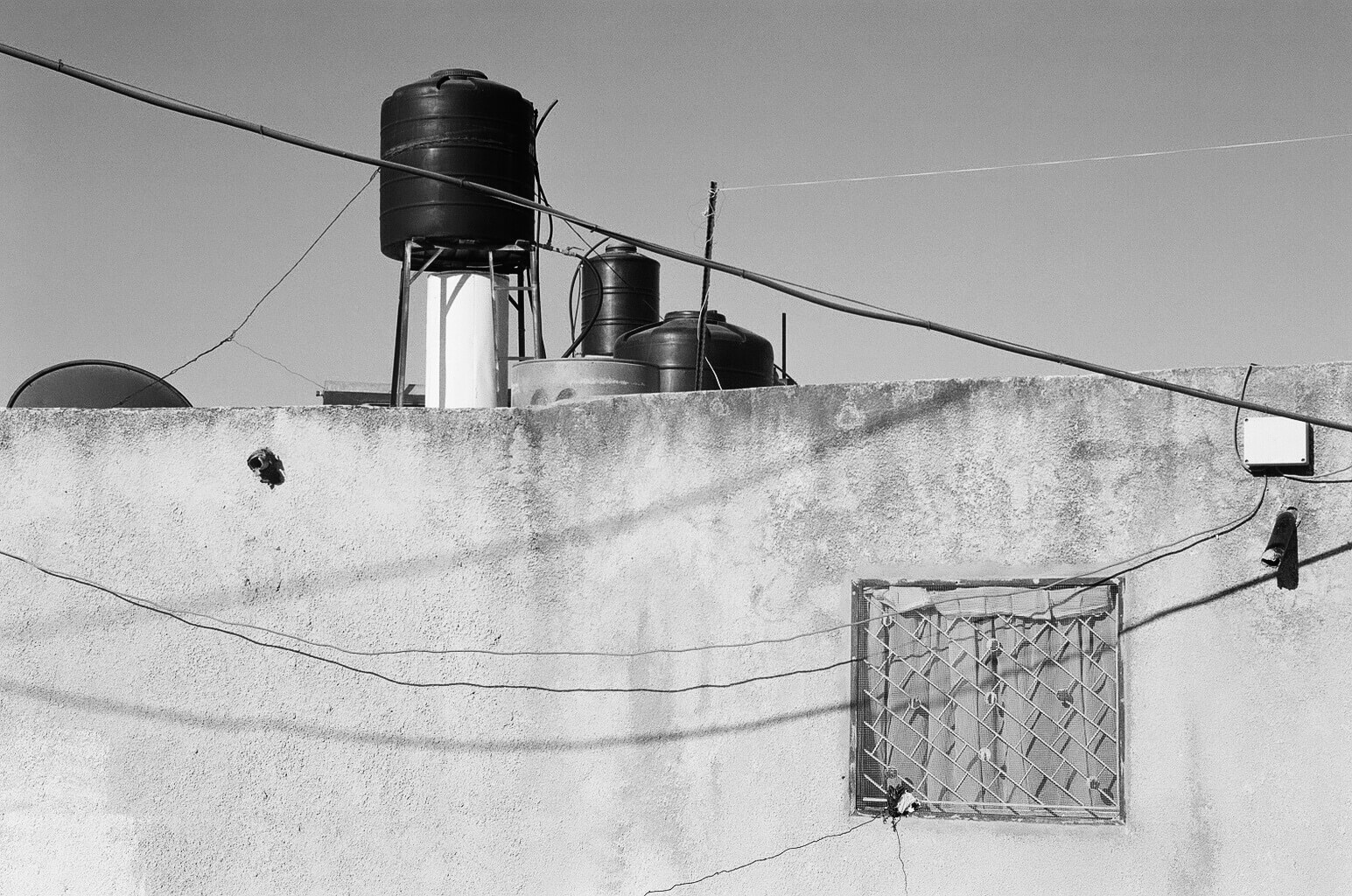
Palestinian homes and villages are easy to recognize from afar by the black water tanks that are used to collect and store supplementary water. During the summer, Palestinian homes in the West Bank receive water deliveries only twice a week, while Jewish Israeli settlements are connected to a constant water supply.
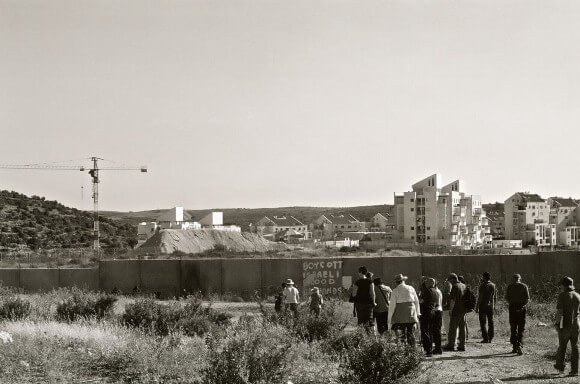
Israeli settlements in the West Bank are easy to spot. Usually built on hilltops, the uniform architecture and matching red roofs are quickly identifiable. Construction of these illegal settlements is continuing daily. Cranes loom over hilltops, casting shadows down on Palestinian villages on hillsides and in valleys. Occupation is implemented vertically, from the top down.
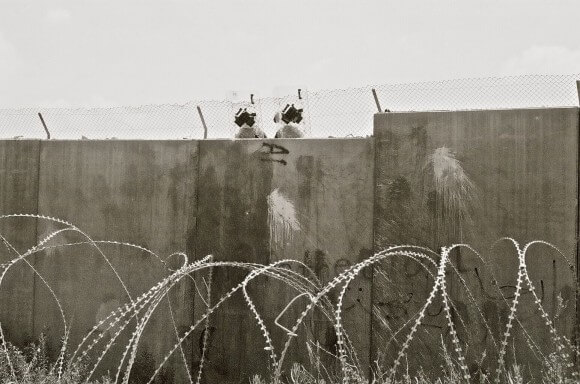
Soldiers in riot gear watch the unarmed demonstrators march alongside the wall at the Bil’in Friday demonstration.
Yet beneath the quotidian architecture of occupation, resistance continues as part of the fabric of everyday life in the Occupied Territories.
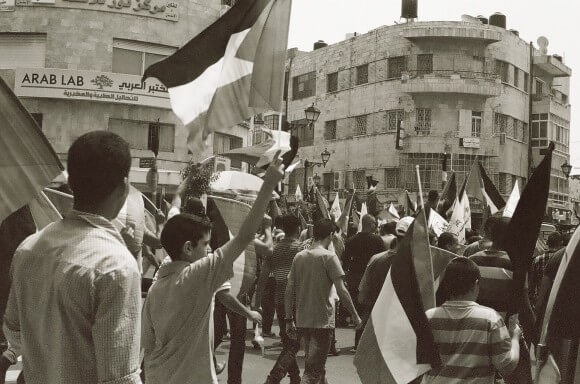
Demonstrators in Ramallah march in support of prisoners on hunger strike. The strikers and their supporters protested the policy of administrative detention, which Israel uses to arbitrarily and indefinitely imprison Palestinians, often for their political involvement. The hunger strike, which involved over 100 prisoners and lasted over two months, ended this week without meeting the demands of strikers. The escalation of force against Palestinian communities in the West Bank as collective punishment for the kidnapping of three Israeli settlers prohibited any progress being made in negotiations to end administrative detention.
In Bil’in, demonstrations continue every Friday to resist the construction of the settlement of Modi’in Illit and the separation wall being built on the village’s land. The weekly demonstrations have become a choreographed dance, with local Palestinians and their international and Israeli partners approaching the wall with slogans, costumes and chants to be met with tear gas and rubber bullets from soldiers on the other side.
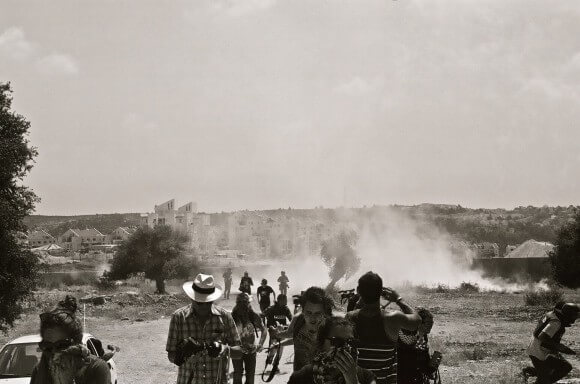
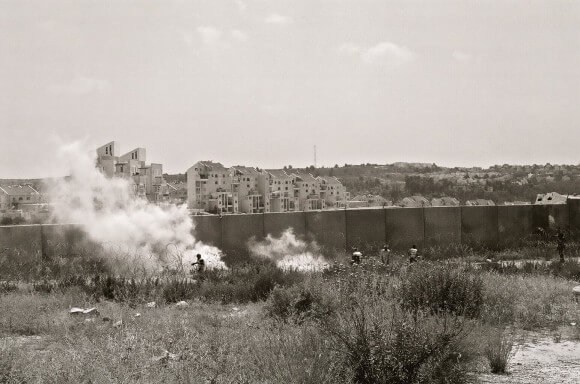
Demonstrators attempt to approach the wall which divides them from the settlement of Modi’in Illit and are met with a barrage of tear gas.
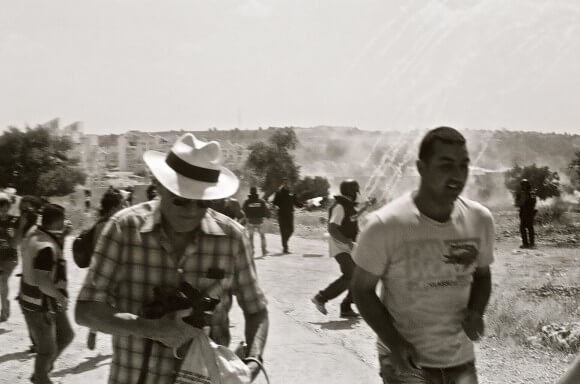
Tear gas rains down on demonstrators and pressmen on Fridays in Bil’in. Fired from automated tanks and hand-held weapons, the tear gas is pungent and the canisters themselves potentially lethal.

A father and daughter lead a march alongside the wall in Bil’in. For children in Bil’in, which has held regular demonstrations against the wall every Friday for nearly 10 years, popular resistance is as much a routine part of everyday life as the Israeli occupation itself.

Members of the Bil’in Popular Resistance Committee– including Iyad Burnat, right– speak with visitors in front of the separation wall. Their resilience and strength, which Palestinians refer to as sumud, or steadfastness, shines in their faces as they describe their weekly protests against the wall which bisects their land. They remind us that, in the face of the daily realities of life under occupation, existence is resistance.
Addendum [written in early July, before the Gaza onslaught]:
As part of an Interfaith Peace-Builders delegation, I met with Palestinian and Israeli activists to witness the effects of the occupation and the work that is being done to work for justice in Palestine-Israel. My intention in participating on this trip was to gain a deeper understanding of the situation through first-hand connection with those for whom occupation and resistance are daily, lived realities. We met with a range of civil society groups, activist organizations, arts organizations and community groups all over the West Bank, East Jerusalem and ’48 Israel.
The trip was a political and emotional rollercoaster. At times I felt deeply saddened and incredibly frustrated by what I was learning and experiencing about the political situation and the mechanisms that enforce the occupation, at others I was inspired and excited by meeting courageous, intelligent and passionate people working for justice in the region. My trip coincided with two major recent events relating to the region– first the Presbyterian divestment and, second, the kidnapping of the three Israeli settler teens– that mirrored this seesaw between feeling inspirational hope and paralyzing despair for the future of the people in the region.
During the week of the conference in which the Presbyterian Church voted to divest from three major companies that profit from the occupation I went to Bethlehem to work with Palestinian activists to write a message in favor of divestment from the Aida refugee camp to the voters at the conference. (See Rae Abileah’s piece). When the historic vote passed, new activist friends I’d met on the trip, both Israelis and Palestinians, celebrated a victory. We felt, and continue to feel, hopeful that this event will be the beginning of a shift in the international, and especially American, political discourse towards recognizing that investment in the occupation and facilitation of the daily violations of Palestinian human rights is immoral, unsustainable, and has to end.
During the same week news of the kidnapping of three Israeli settler teens came out, and a large-scale escalation of military force began in the West Bank and Gaza. I am deeply saddened and disturbed by the tragic killing of these three three young men, as well as by the horrific collective punishment and tragic killings of Palestinians in retaliation violence in the West Bank and Gaza. The racialized hatred, incitement to violence, and exertions of force by the IDF in the West Bank and Gaza that this event has sparked is horrifying and further reinscribes the divisions and disproportionalities of force and power that characterize this “conflict.” These events, which forced hunger-striking prisoners to end their protest without winning concessions in the fight to end unjust administrative detentions and which Israel is using to destroy the possibility of a Fatah-Hamas unity government, are a major setback for all of those working for a just peace.
The everyday violence of the occupation, and the resistance against it, will continue after this episode of bombing ends, with far less attention and outcry. I’m back home now and watching the news closely, worrying about the safety and well-being of my new friends and everyone in who calls this fraught region home.
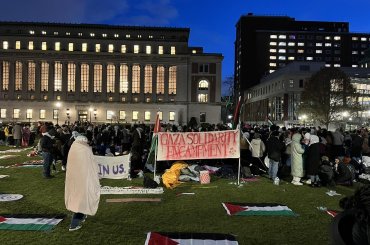

Wonderful, Naomi. I was visiting the West Bank from the U.S. at the same time, but your photos capture much more than mine.
Cool photos, but Naomi, didn’t you get the memo? It’s not a wall, it’s a fence. A friendly white picket fence, right out of Norman Rockwell. Israel’s just a friendly ole neighbor, like Bob.
Here is an article that looks at how much money American taxpayers are putting into this conflict:
http://viableopposition.blogspot.ca/2014/08/the-funding-irony-of-israeli-hamas.html
The irony of Washington’s approach to the ongoing hostilities in Gaza should be of great concern to taxpayers.